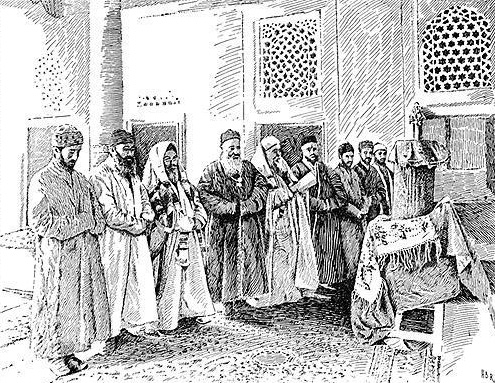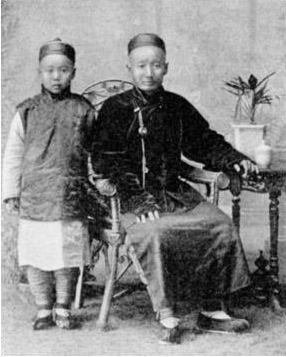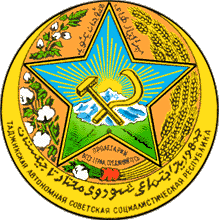|
Bukharan Jews
Bukharan Jews (Bukharian: יהודיאני בוכארא/яҳудиёни Бухоро, ''Yahudiyoni Bukhoro''; he, יהודי בוכרה, ''Yehudey Bukhara''), in modern times also called Bukharian Jews (Bukharian: יהודיאני בוכארי/яҳудиёни бухорӣ, ''Yahudiyoni Bukhorī''; he, יהודים בוכרים, ''Yehudim Bukharim''), are an ethnoreligious Jewish sub-group of Central Asia that historically spoke Bukharian, a Judeo-Tajik dialect of the Tajik language, in turn a variety of the Persian language. Their name comes from the former Central Asian Emirate of Bukhara (now primarily Uzbekistan), which once had a sizable Jewish population. Bukharan Jews comprise Persian-speaking Jewry along with the Jews of Iran, Afghanistan, and the Caucasus Mountains. Since the dissolution of the Soviet Union, the great majority have immigrated to Israel or to the United States while others have immigrated to Europe or Australia. Bukharan Jews are Mizrahi Jews.G ... [...More Info...] [...Related Items...] OR: [Wikipedia] [Google] [Baidu] |
Persian Jews
Persian Jews or Iranian Jews ( fa, یهودیان ایرانی, ''yahudiān-e-Irāni''; he, יהודים פרסים ''Yəhūdīm Parsīm'') are the descendants of Jews who were historically associated with the Persian Empire, whose successor state is Iran. The biblical books of Book of Esther, Esther, Book of Isaiah, Isaiah, Book of Daniel, Daniel, Book of Ezra, Ezra, and Book of Nehemiah, Nehemiah contain references to the lives and experiences of Jews who lived in Achaemenid Empire, Persia. Dating back to biblical times, Iranian Jews constitute one of the world's oldest and most History of the Jews in Iran, historically significant Jewish communities. Jews have had a History of the Jews in Iran, continuous presence in Iran since the time of Cyrus the Great of the Achaemenid Empire. Cyrus invaded Babylon and freed the Jews from the Babylonian captivity. Today, the vast majority of Iranian Jews in Israel, Persian Jews live in Israel and the United States, especially in Los Ange ... [...More Info...] [...Related Items...] OR: [Wikipedia] [Google] [Baidu] |
Jews
Jews ( he, יְהוּדִים, , ) or Jewish people are an ethnoreligious group and nation originating from the Israelites Israelite origins and kingdom: "The first act in the long drama of Jewish history is the age of the Israelites""The people of the Kingdom of Israel and the ethnic and religious group known as the Jewish people that descended from them have been subjected to a number of forced migrations in their history" and Hebrews of historical Israel and Judah. Jewish ethnicity, nationhood, and religion are strongly interrelated, "Historically, the religious and ethnic dimensions of Jewish identity have been closely interwoven. In fact, so closely bound are they, that the traditional Jewish lexicon hardly distinguishes between the two concepts. Jewish religious practice, by definition, was observed exclusively by the Jewish people, and notions of Jewish peoplehood, nation, and community were suffused with faith in the Jewish God, the practice of Jewish (religious ... [...More Info...] [...Related Items...] OR: [Wikipedia] [Google] [Baidu] |
Tajiks
Tajiks ( fa, تاجيک، تاجک, ''Tājīk, Tājek''; tg, Тоҷик) are a Persian language, Persian-speaking Iranian peoples, Iranian ethnic group native to Central Asia, living primarily in Afghanistan, Tajikistan, and Uzbekistan. Tajiks are the largest ethnicity in Tajikistan, and the second-largest in Afghanistan and Uzbekistan. They speak varieties of Persian, a Western Iranian language. In Tajikistan, since the 1939 Soviet census, its small Pamiris, Pamiri and Yaghnobi people, Yaghnobi ethnic groups are included as Tajiks. In China, the term is used to refer to its Pamiri ethnic groups, the Tajiks of Xinjiang, who speak the Eastern Iranian languages, Eastern Iranian Pamiri languages. In Afghanistan, the Pamiris are counted as a separate ethnic group. As a self-designation, the literary Persian language, New Persian term ''Tajik'', which originally had some previous pejorative usage as a label for eastern Persian peoples, Persians or Iranian peoples, Iranians, has beco ... [...More Info...] [...Related Items...] OR: [Wikipedia] [Google] [Baidu] |
Samarkand
fa, سمرقند , native_name_lang = , settlement_type = City , image_skyline = , image_caption = Clockwise from the top: Registan square, Shah-i-Zinda necropolis, Bibi-Khanym Mosque, view inside Shah-i-Zinda, Sher-Dor Madrasah in Registan, Timur's Mausoleum Gur-e-Amir. , image_alt = , image_flag = , flag_alt = , image_seal = Emblem of Samarkand.svg , seal_alt = , image_shield = , shield_alt = , etymology = , nickname = , motto = , image_map = , map_alt = , map_caption = , pushpin_map = Uzbekistan#West Asia#Asia , pushpin_map_alt = , pushpin_mapsize = 300 , pushpin_map_caption = Location in Uzbekistan , pushpin_label_position = , pushpin_relief = 1 , coordinates = , coor_pinpoint = ... [...More Info...] [...Related Items...] OR: [Wikipedia] [Google] [Baidu] |
Kaifeng Jews
The Kaifeng Jews ( zh, t=開封猶太族, p=Kāifēng Yóutàizú; he, יהדות קאיפנג ''Yahădūt Qāʾyfeng'') are members of a small community of descendants of Chinese Jews in Kaifeng, in the Henan province of China. In the early centuries of their settlement, they may have numbered around 2,500 people. Despite their isolation from the rest of the Jewish diaspora, their ancestors managed to preserve Jewish traditions and customs for several centuries. The distinctive customary life of this Kaifeng community slowly eroded, as assimilation and intermarriage with Han Chinese and Chinese Muslim neighbours advanced, until, by the 19th century, their Jewishness became largely extinct, apart from the retention of clan memories of their Jewish past. The origin and time of settlement in Kaifeng of these Jews are a matter of intense debate among experts. While Kaifeng Jewish descendents are assimilated into mainstream Chinese culture, some are trying to revive their ancestr ... [...More Info...] [...Related Items...] OR: [Wikipedia] [Google] [Baidu] |
History Of The Jews In The United States
There have been Jewish communities in the United States since colonial times. Early Jewish communities were primarily Sephardi (Jews of Spanish and Portuguese descent), composed of immigrants from Brazil and merchants who settled in cities. Until the 1830s, the Jewish community of Charleston, South Carolina, was the largest in North America. In the late 1800s and the beginning of the 1900s, many Jewish immigrants arrived from Europe. For example, many German Jews arrived in the middle of the 19th century, established clothing stores in towns across the country, formed Reform synagogues, and were active in banking in New York. Immigration of Eastern Yiddish-speaking Ashkenazi Jews, in 1880–1914, brought a new wave of Jewish immigration to New York City, including many who became active in socialism and labor movements, as well as Orthodox and Conservative Jews. Refugees arrived from diaspora communities in Europe after the Holocaust and, after 1970, from the Soviet Union. ... [...More Info...] [...Related Items...] OR: [Wikipedia] [Google] [Baidu] |
Aliyah
Aliyah (, ; he, עֲלִיָּה ''ʿălīyyā'', ) is the immigration of Jews from the diaspora to, historically, the geographical Land of Israel, which is in the modern era chiefly represented by the State of Israel. Traditionally described as "the act of going up" (towards the Jewish holy city of Jerusalem), moving to the Land of Israel or "making aliyah" is one of the most basic tenets of Zionism. The opposite action—emigration by Jews from the Land of Israel—is referred to in the Hebrew language as '' yerida'' (). The Law of Return that was passed by the Israeli parliament in 1950 gives all diaspora Jews, as well as their children and grandchildren, the right to relocate to Israel and acquire Israeli citizenship on the basis of connecting to their Jewish identity. For much of their history, most Jews have lived in the diaspora outside of the Land of Israel due to various historical conflicts that led to their persecution alongside multiple instances of expu ... [...More Info...] [...Related Items...] OR: [Wikipedia] [Google] [Baidu] |
Dissolution Of The Soviet Union
The dissolution of the Soviet Union, also negatively connoted as rus, Разва́л Сове́тского Сою́за, r=Razvál Sovétskogo Soyúza, ''Ruining of the Soviet Union''. was the process of internal disintegration within the Soviet Union (USSR) which resulted in the end of the country's and its federal government's existence as a sovereign state, thereby resulting in its constituent republics gaining full sovereignty on 26 December 1991. It brought an end to General Secretary Mikhail Gorbachev's (later also President) effort to reform the Soviet political and economic system in an attempt to stop a period of political stalemate and economic backslide. The Soviet Union had experienced internal stagnation and ethnic separatism. Although highly centralized until its final years, the country was made up of fifteen top-level republics that served as homelands for different ethnicities. By late 1991, amid a catastrophic political crisis, with several republics alr ... [...More Info...] [...Related Items...] OR: [Wikipedia] [Google] [Baidu] |
Uzbekistan
Uzbekistan (, ; uz, Ozbekiston, italic=yes / , ; russian: Узбекистан), officially the Republic of Uzbekistan ( uz, Ozbekiston Respublikasi, italic=yes / ; russian: Республика Узбекистан), is a doubly landlocked country located in Central Asia. It is surrounded by five landlocked countries: Kazakhstan to the north; Kyrgyzstan to the northeast; Tajikistan to the southeast; Afghanistan to the south; and Turkmenistan to the southwest. Its capital and largest city is Tashkent. Uzbekistan is part of the Turkic world, as well as a member of the Organization of Turkic States. The Uzbek language is the majority-spoken language in Uzbekistan, while Russian is widely spoken and understood throughout the country. Tajik is also spoken as a minority language, predominantly in Samarkand and Bukhara. Islam is the predominant religion in Uzbekistan, most Uzbeks being Sunni Muslims. The first recorded settlers in what is now Uzbekistan were Eastern Irania ... [...More Info...] [...Related Items...] OR: [Wikipedia] [Google] [Baidu] |
Emirate Of Bukhara
The Emirate of Bukhara ( fa, , Amārat-e Bokhārā, chg, , Bukhārā Amirligi) was a Muslims, Muslim polity in Central Asia that existed from 1785 to 1920 in what is modern-day Uzbekistan, Tajikistan, Turkmenistan and Kazakhstan. It occupied the land between the Amu Darya and Syr Darya rivers, known formerly as Transoxiana. Its core territory was the fertile land along the lower Zarafshon river, and its urban centres were the ancient cities of Samarqand and the emirate's capital, Bukhara. It was contemporaneous with the Khanate of Khiva to the west, in Khwarazm, and the Khanate of Kokand to the east, in Fergana Valley, Fergana. In 1920, it ended with the establishment of the Bukharan People's Soviet Republic. History The Emirate of Bukhara was officially created in 1785, upon the assumption of rulership by the Manghit emir, Shah Murad. Shahmurad, formalized the family's dynastic rule (Manghit, Manghit dynasty), and the khanate became the Emirate of Bukhara. As one of t ... [...More Info...] [...Related Items...] OR: [Wikipedia] [Google] [Baidu] |
Persian Language
Persian (), also known by its endonym and exonym, endonym Farsi (, ', ), is a Western Iranian languages, Western Iranian language belonging to the Iranian languages, Iranian branch of the Indo-Iranian languages, Indo-Iranian subdivision of the Indo-European languages. Persian is a pluricentric language predominantly spoken and used officially within Iran, Afghanistan, and Tajikistan in three mutual intelligibility, mutually intelligible standard language, standard varieties, namely Iranian Persian (officially known as ''Persian''), Dari, Dari Persian (officially known as ''Dari'' since 1964) and Tajik language, Tajiki Persian (officially known as ''Tajik'' since 1999).Siddikzoda, S. "Tajik Language: Farsi or not Farsi?" in ''Media Insight Central Asia #27'', August 2002. It is also spoken natively in the Tajik variety by a significant population within Uzbekistan, as well as within other regions with a Persianate society, Persianate history in the cultural sphere of Greater Ira ... [...More Info...] [...Related Items...] OR: [Wikipedia] [Google] [Baidu] |
Tajik Language
Tajik (Tajik: , , ), also called Tajiki Persian (Tajik: , , ) or Tajiki, is the variety of Persian spoken in Tajikistan and Uzbekistan by Tajiks. It is closely related to neighbouring Dari with which it forms a continuum of mutually intelligible varieties of the Persian language. Several scholars consider Tajik as a dialectal variety of Persian rather than a language on its own. The popularity of this conception of Tajik as a variety of Persian was such that, during the period in which Tajik intellectuals were trying to establish Tajik as a language separate from Persian, prominent intellectual Sadriddin Ayni counterargued that Tajik was not a "bastardised dialect" of Persian.Shinji ldoTajik Published by UN COM GmbH 2005 (LINCOM EUROPA) The issue of whether Tajik and Persian are to be considered two dialects of a single language or two discrete languages has political sides to it. By way of Early New Persian, Tajik, like Iranian Persian and Dari Persian, is a continuatio ... [...More Info...] [...Related Items...] OR: [Wikipedia] [Google] [Baidu] |





.jpg)

